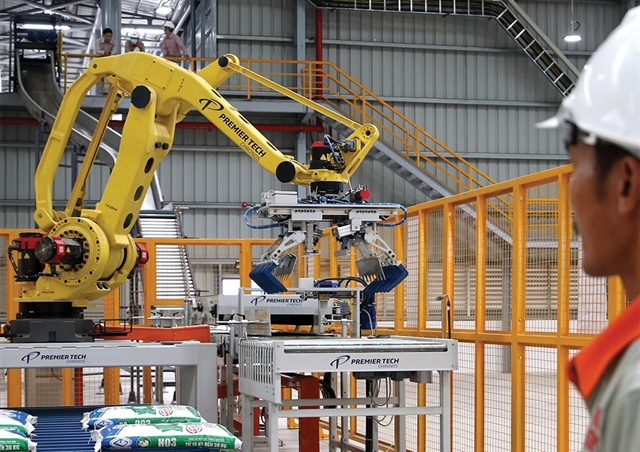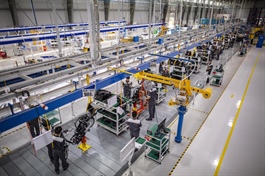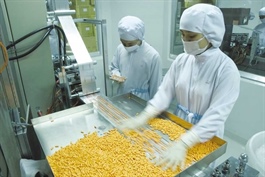Solving cost puzzle vital for enterprises to level up
Solving cost puzzle vital for enterprises to level up
Autonomous production and deeper participation in global supply chains are helping Vietnam move beyond the role of a processing workshop.

Local manufacturers are encouraged to focus on using more technology, photo Le Toan |
Last week, the government set out rules for public-private partnerships in the development of science and technology, innovation, and digital transformation. This aims to continue removing institutional bottlenecks and create more favourable conditions to enhance public-private cooperation in these crucial areas.
The move is expected to address regulatory barriers while unlocking further opportunities to promote collaboration in key sectors, thereby strengthening the internal capacity and global value chain participation of Vietnamese enterprises.
Nevertheless, in reality, the path remains fraught with challenges. A survey on the current level of global value chain participation by Vietnamese businesses, published a month ago by the Vietnam Chamber of Commerce and Industry (VCCI), revealed that almost two-thirds of the surveyed enterprises admitted to having no clear preparation.
Notably, Vietnamese firms often struggle to meet delivery timelines and technical standards, and only about 15 per cent have a comprehensive long-term strategy.
Luong Minh Huan of the VCCI’s Enterprise Development Institute, acknowledged that one of Vietnam’s weaknesses lies in its lack of control over supply and industrial value chains. The country lacks leading enterprises to drive the sector, while connections and support for small and medium-sized enterprises (SMEs) remain limited.
“The localisation rate in the electronics industry is only around 5-10 per cent, and in automotives around 7-10 per cent – far below set targets and behind regional peers,” Huan said. “Vietnam primarily produces simple tech components, while high-tech, high-value-added parts still rely heavily on imports,” he added.
In the country’s industrial development strategy issued in February, the promotion of industrial development is among the key areas aimed at turning Vietnam into a modern industrial nation.
Likewise, in 2024 Vietnam set an ambitious target for the digital economy to contribute 30 per cent of GDP by 2030 and 50 per cent by 2045. To achieve this, Vietnam must make substantial investments in science and technology, with a minimum of 3 per cent of the annual state budget allocated for this purpose, and societal investment reaching over 2 per cent of GDP by 2030.
Chu Viet Cuong, director of the Industrial Development Support Centre under the Department of Industry at the Ministry of Industry and Trade, stated that in order to build autonomous industrial capacity and a sustainable supply chain, businesses must focus on technology and innovation, industry links and cluster development, and the development of high-quality technical personnel.
“We’ve implemented many support programmes for mechanical and automation enterprises, particularly SMEs. Every year, the centre runs CEO and technician training courses and partners with large corporations like Samsung and Toyota, as well as research institutes from Japan and South Korea, to deliver initiatives on machining, testing, and standard laboratory models,” he stressed.
Of note, the centre currently owns a modern machinery system, which businesses can use free of charge during trial production – supporting the enhancement of technological capabilities from the earliest stages.
Tran Van Le, CEO of Phuong Linh Group, a company with 25 years of experience in industrial fan manufacturing, said that he once had to invest hundreds of thousands of US dollars just to build a cleanroom meeting international standards, suitable for receiving foreign technologies.
“Our products apply high technology in up to 80 per cent of the production process, with 70-75 per cent local manufacturing, across two factories in Hanoi and Tay Ninh province. Soon, we’ll open another plant in central Vietnam. We’ve successfully exported our products to South Korea and Japan, and aim to be among the top 20 leading firms in the industry in Vietnam,” Le said.
He also pointed out that SMEs often lack consistency, long-term vision, and investment mindset due to fear of high risk. As such, if a business is not willing to invest at least $200,000 for a standardised process – from personnel to technology and factory infrastructure – it will never truly master the technology.
According to Cao Dai Thang, chairman of Intech Group, many projects fail not because of poor ideas, but due to high initial investment costs that exceed the financial capacity of startups. Therefore, solving the cost puzzle could open up international cooperation opportunities for Vietnamese enterprises – making the dream of high-tech manufacturing in Vietnam entirely achievable.
“During our development journey, we’ve witnessed a shift in the role of domestic enterprises. In the past, only foreign-invested firms joined high-tech projects, but gradually, Vietnamese companies like Intech have risen to become vendors and have taken on more proactive roles in various stages of the production value chain,” Thang said.
- 09:28 16/07/2025























